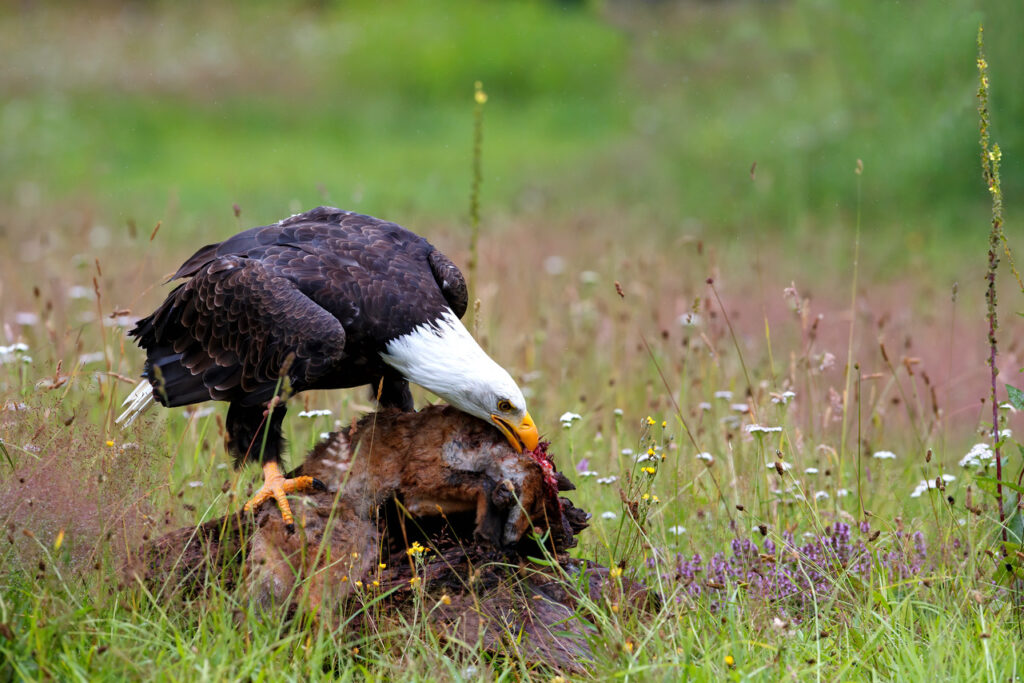
Bald-Faced Slaughter of America’s Eagles
Science Study Documents Continent-Wide Effects of Lead Ammo on Eagles
- Wayne Pacelle
If sport hunters had shot and injured or killed thousands, or even tens of thousands of bald and golden eagles, there’d be an uninterrupted uproar. Rightly so. The perpetrators, if there were any justice, would be prosecuted under the Migratory Bird Treaty Act. Or, under the Bald and Golden Eagle Protection Act. And school kids would plead with the President to protect the national bird.
It turns out that while common hunters are not lining the great birds up in their gunsights, their lead ammunition is still finding them and breaking down their bodies.
A study published last week in the journal Science documented mass poisoning of eagles by lead scattered across our wildlands. Fragments of lead ammunition in the remains (so-called “gut piles”) of hunted animals are having population-level effects on eagles.
The eight-year study of 1,210 bald and golden eagles across 38 states—co-authored by dozens of wildlife scientists—determined that 46 to 47 percent of eagles had “bone lead concentrations above thresholds for chronic poisoning.” According to the study, a third of eagles had “acute [lead] poisoning.”
From DDT to Lead Ammo
Decades ago, Rachel Carson startled the world with Silent Spring, a book that documented the effects of pesticides on wildlife. One silent killer was the insecticide DDT (Dichlorodiphenyltrichloroethane), which had the effect of thinning bald eagle eggshells and snuffing out the lives of the next generation. The EPA in 1972 banned the compound that threatened animals and people, and a year later, the Congress enacted the Endangered Species Act in 1973 partly to address this crisis.
Over the objections of the National Rifle Association (NRA) and other hunting groups, conservationists and animal welfare advocates, during the Reagan and Bush presidencies, pushed the U.S. Fish and Wildlife Service to ban the use of lead ammunition in waterfowl hunting in 1991. “Plumbism [lead poisoning] was first seen in ducks in 1874,” wrote conservation writer Ted Williams, “but it wasn’t until 1991 that the U.S. Fish and Wildlife Service got around to banning lead shot for waterfowl.” It is estimated to have saved as many as 1.4 million ducks, geese and other migratory waterfowl every year since.
But we haven’t heeded the lessons of lead for more than 100 other species. Widespread hunting with lead ammo is a full-employment plan for wildlife rehabilitators and emergency-room wildlife veterinarians, and it seems thoroughly counter-productive for hunters whose hobby depends on some measure of wildlife abundance.
Sport hunters often proudly cite the legacy of President Teddy Roosevelt, perhaps one of our nation’s best-known conservationists and hunters. Roosevelt understood though that “conserve” is an action verb and it requires action in the present. Today’s hunters who use lead don’t get a pass for the wreckage of today by associating themselves with a conservation-minded hunter of yesteryear, especially one who died more than a century ago.
The Eagle Has Landed – With a Thud
Think about the numbers. If one-third of the 30,000 golden eagles and 300,000 bald eagles suffer from acute lead toxicity, perhaps tens of thousands of eagles are dying from plumbism.
There may be more than 20 million wild animals of all species who die every year from lead poisoning, with the ground-feeding birds mistaking the lead fragments for seeds, and predators and carrion feeders consuming the remains of gut piles peppered with lead. Death from lead poisoning is painful, and even when lead exposure isn’t high enough to kill an animal, it doesn’t take much to weaken an animal to the point that it succumbs to predation or disease.
We’ve known that lead kills for 2,000 years. In recent decades, to protect people, lead has been removed from paint, gasoline, and lead pipes because of its toxicity. Alternatives to using lead abound for hunters, with steel, copper and bismuth ammunition available and affordable. California banned all lead ammunition in July 2019, and hunters do not report shortages or dissatisfaction.
The scientific and anecdotal evidence is as attention-getting as a 21-gun salute – with lead being the leading cause of death for years for the highly endangered California condor, to higher lead levels in the blood for families relying on the meat of wild animals, to wildlife rehabilitation centers taking in animals with deadened eyes and quivering bodies.
But sadly, the NRA contrives a conspiracy even when it’s in their self-interest to seek reform. Poke around on the websites of the biggest ammo manufacturers, and even there you’ll find the firearms industry singing the praises of lead alternatives. “Looking for premium performance without the premium price?” asks one brand-name maker of steel shot. Others note that steel ammo “delivers denser patterns for greater lethality and is zinc-plated to prevent corrosion.”
In the weeks after the Biden Administration took over, its new leaders touted it was opening dozens more of our 570 National Wildlife Refuges to hunting. But not a word about the effects of permitting the scattering of thousands more pounds of lead to cause dizziness, disease, and death for wildlife living on land areas falsely designated as “refuges.”
Congressman Ted Lieu has a bill, H.R. 405, to ban the use of lead ammo on national wildlife refuges. This Administration has a duty to take care of the problem itself through a rulemaking action. A requirement to use non-toxic ammunition on these lands would belatedly hit the bullseye in ending decades of unintended and unnecessary destruction of our nation’s cherished wildlife.